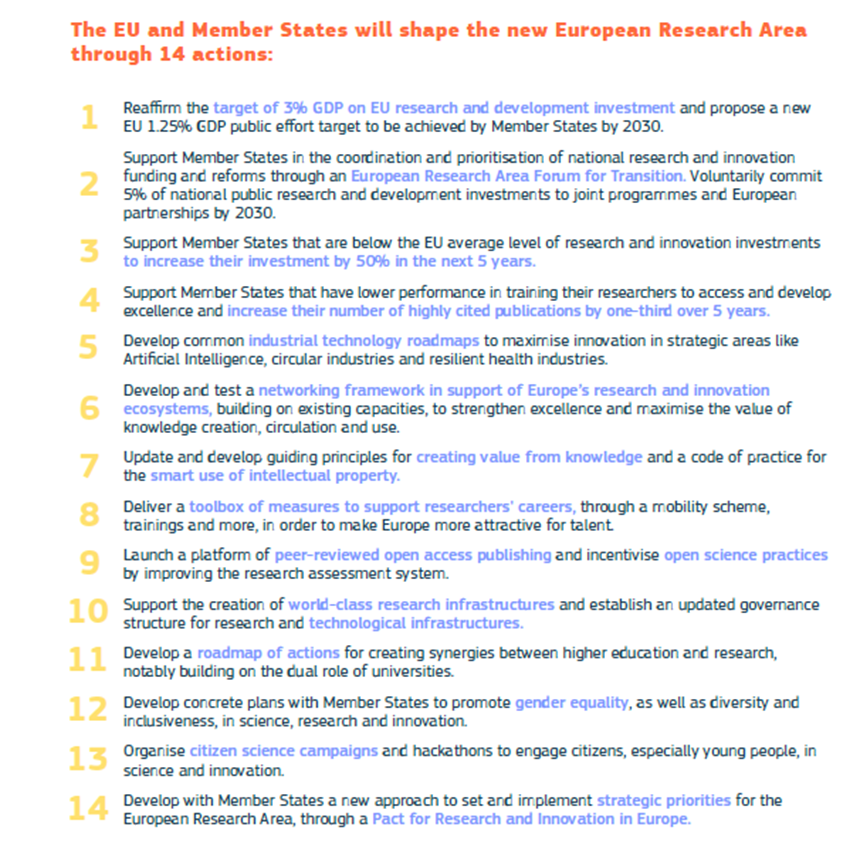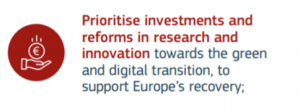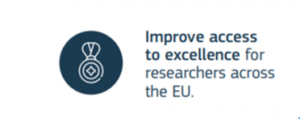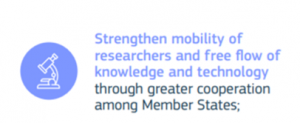We already know the European Commission’s Communication on the new European Research Area (ERA) in the field of research and innovation (R&I) announced on September 30, 2020. Recently on our website we described the history of the ERA and its main objectives, while below we present the content of the release, which describes the renewed European Research Area. So what will the new ERA be like? What are its strategic goals and expected results? How it is going to differ from the “previous” ERA, especially at a time of social, environmental and economic challenges escalated by the Covid-19 pandemic? Feel free to read!
NEW ERA
Based on its experience, the European Commission has outlined the new ERA development priorities. Their implementation will accelerate the R&I progress of research and innovation towards a green, climate-neutral, digital Europe that will invest in breakthrough research, risky innovations and boldly compete in the global industry and economic market. It will also be Europe oriented towards scientific excellence, open science, cooperation of leading researchers and innovators, supporting scientific talents and creating an attractive labour market.
The particular 14 actions announced by the Commission will play a key role in achieving the new objectives of the European Research Area (for details see picture below). It will also be important to cooperate more closely with the Member States, for which an European Forum for Transition will be the new discussion platform. In addition, the Commission proposes EU countries an adoption of a Pact for Research and Innovation in Europe (2021), which will define common values, principles of cooperation, strategic areas of action, as well as tools of their implementation and monitoring.

STRATEGIC GOALS OF THE ERA
In its Communication the European Commission identified the following four strategic objectives for ERA:
1. Prioritize investments and reforms in research and innovation

To achieve this goal, the European Commission suggests to the Member States to increase R&I investment, in particular the areas of key importance for the development of Europe, i.e. digital technologies, microelectronics, renewable energy, advance towards a climate-neutral continent and a circular economy. The Commission proposes to maintain the target of 3% of GDP spending on research and innovation, while encouraging Member States to increase their public R&D expenses to at least 1.25%. At the same time, EU countries are encouraged to volunteer 5% of their national R&D funding for joint European programs and partnerships by 2030.
The contribution of the European Commission itself will be the expenditures planned for the years 2021-2027 on different instruments of the new Horizon Europe framework program. Horizon Europe (HE) is expected to effectively counteract the existing fragmentation of activities and R&D investment. Its first pillar is to build a solid foundation for basic research. The second pillar will ensure well-coordinated cooperation between the EU, Member States and industry on jointly defined priorities in the fields of health, industry and economy, energy, biodiversity, climate, food, etc. The new instruments for this cooperation will be “missions” and cross-border “partnerships”. Meanwhile, the third pillar of Horizon Europe will focus on the development of breakthrough innovation around which European Innovation Council (EIC) and the European Institute of Innovation and Technology (EIT) have been building their activities.
2. Improve access to excellent facilities and infrastructures for researchers across the EU

Being aware of the current unbalanced R&D expenditure of individual Member States, the EC has set itself the goal of filling these gaps in order to provide researchers from different EU countries with equal access to research excellence and infrastructures. To achieve this goal the Commission plans e.g. to support R&D staff through different programmes developing competences and strengthening mobility between academia and industry. At the same time, the EU countries lagging behind the EU average of R&I investment over GDP will be asked to rise their expenditure by 50% in the next 5 years. Under Horizon Europe the development of excellence in the widening countries will be supported by instruments such as Twinning, Teaming, ERA Chairs.
Among all new ideas there are two initiatives deserving special mention: 1. the “Science meets regions” initiative facilitating dialogue and supporting regions and cities; 2. the ERA4You initiative supporting the mobility of scientists and the knowledge exchange between researchers and entrepreneurs. ERA4You is also to monitor and effectively eliminate the disproportions in the access of scientists and institutions to the best infrastructures and research facilities in various regions of Europe.
3. Transfer of R&I results to the economy

The Commission intends to respond to this particular challenge by developing roadmaps of action – common to European universities, technology and industry – that will attract even more private investors ready to get involved in cross-border and cross-sectorial projects. This will reinforce the competitiveness of European technology in key strategic areas. The Commission’s aim is to rapidly transform excellent science into ground-breaking innovations and to mobilize the potential of the less technologically developed regions of the EU. An interesting solution from the point of view of researchers and institutes of the Polish Academy of Sciences might be developing a networking framework based on already existing centers of excellence and Digital Innovation Hubs, which will enable the brain circulation. Moreover, the Commission plans to develop a code of practice for the intellectual property protection over the next 2 years.
4. Strengthen mobility of researchers and free flow of knowledge and technology

Several areas of particular attention have been identified in this field.
- Support for career development
The Commission’s plans include strengthening the existing programs for mobility of researchers – both in the geographical dimension and in the sense of the circulation of knowledge and ideas between science and technology. The new ERA intends to introduce a number of instruments to overcome the imbalance between the number of doctoral graduates and the number of jobs in public research institutions. Also, the ERA aims to prevent the mismatch between researchers’ competences and new challenges of the changing labour market. Strengthening the exchange between academia and business, investing in new competences of scientists and encouraging them to entrepreneurship are just some of the examples. Apart from the aforementioned ERA4You program, noteworthy is the idea of creating an ERA Talent Platform, a comprehensive portal supporting the scientific career development, which is being built on EURAXESS resources and experiences. The improvement of the remuneration system and the development of the pan-European pension fund for researchers (RESAVER) is also to be a great support for mobility.
- Open Science
The development of the European Open Science Cloud (EOSC) – an European data sharing platform and the pre-announced Open Research Europe publishing platform are just some of the measures taken by the Commission to provide researchers and all potential stakeholders with fully open, unlimited and free of charge access to publicly funded research data and results. These and many other activities for Open Science are intended to lead to an unhindered knowledge circulation, deepening cooperation, and thus to even more creative and efficient research and innovation.
- Gender equality
The European Commission strives to work closely with member states and stakeholders to bring new solutions to promote gender equality in the field of R&D. Given that women are still under-represented in EU research (33.4%), the ERA intends to strongly support their participation in various fields of science, technology, engineering and mathematics (STEM) and to promote female entrepreneurship. Moreover, the ERA does not intend to remain indifferent to violence in R&D organizations, as well as discrimination on the basis of gender, ethnic origin, disability or sexual orientation.
- Infrastructures
The activities of the European Strategy Forum on Research Infrastructures – ESFRI, supported by the European Commission, focus mainly on improvement of the world-class research infrastructure and effective cooperation of the already existing European networks. E-infrastructures, in particular connectivity and collaboration services, will play an extremely important role in exploiting their full potential. Ultra-fast connectivity will become the basis for using digital twin-like models of reality. Furthermore, access to the proper infrastructure will allow industry and SMEs to develop and test their innovation quickly so as to successfully bring them into the market. To enable this, the ERA aims to expand the mapping of available facilities, as well as work on new recommendations on access conditions and infrastructure management. Research infrastructures will also support the regional development by attracting innovative skills and talents. The creation of infrastructures, such as the European Spallation Source, the European Plate Observing System and the European Social Survey has been a huge success of the current ERA.
CITIZENS ENGAGEMENT & EDUCATION
Even greater involvement of citizens and various stakeholders (especially the young generation, NGOs, local governments, municipalities, local communities, socially excluded groups) will be an extremely important element of the new ERA. Easy and understandable communication not only of ready solutions, but also of preliminary research, will give society a real impact on directions of future science, technology and innovation improvement. In addition to that, the Commission intends to invite research funding organisations to develop guidelines and good practices for motivating and rewarding citizens’ participation in the R&I area.
The new ERA aims to intensify the integration of different actors responsible for education, training and labor market to help researchers with better planning and boosting their careers. Digital education has recently become an important area of work for the Commission, which new action plan was adopted on 30 September 2020. Priority was given to creating targeted training and aligning EU countries’ educational systems to the digital age, which will consequently support digital Europe.

Europe looks ahead and responds to the huge challenges it faces by setting itself ambitious goals. The Commission, Member States and R&D stakeholders have an important role to play in this crucial moment to build a green, digitally strengthened, competitive European Union.
We are very curious which elements of the ERA you consider as the most important for an individual researcher’s development and/or for the strategic improvement of R&D institutions in Poland. If you would like to share with us your opinion and be engaged in the future discussion around the ERA and Horizon Europe instruments, please contact us at: polsca@polsca.pan.pl
We encourage you to follow the activity of the PolSCA Office on our website, as well as on the Facebook profile. If you want to receive similar information and to be regularly updated via PolSCA Office, subscribe to our newsletter!
Published: 2020-10-20, J. Komperda
Translated: 2020-10-23, J. Komperda



